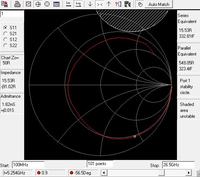Terminator3
Advanced Member level 3

Negative resistance oscillator, how to get rid of wrong highfrequency of oscillation?
I am following RF design book and tutorials on negative resistance oscillator, but encounter some problems.
My design is 5GHz oscillator. I want to use single device, so i decided to use NE3210S01, it has very high gain, there are many papers with push-push, etc. oscillators, where NE3210S01 fundamental oscillation is at 3...9 GHz. My idea is that this device can give good harmonic level at 10GHz.
So i use this approach: take s-parameters at 5GHz, check for stability factors, add inductance if needed, update S-parameters in new configuration. Then choose Gsource near to inverse of S11, calculate Gout and decide Gload, correct Gload. Check that Gsource and Gload are in unstable regions. Problem is that in transient simulations i currently obtain some unwanted result like 11 to 15 GHz.
So it looks like Gin*Gs=1, Gout*Gload=1, k<1 conditions are matched at those higher frequencies.
I came to a conclusion, that i must draw all stability circles from 1 to 20 GHz, and draw Gload-Gsource impedance points too, and check all frequencies for instability. Actually there must be some wide band analysis, like building stable LNA. But it is pretty odd, because i come to conclusion that series and shunt resistances must be added to make transistor stable at 9..15GHz. Why i think it is strange, because authors who used NE3210S01 in oscillators (push-push, etc.) did not use any series resistances. I am pretty sure that transient simulation is correct, because it gives good results for book examples. Also gain and unstability factor at frequencies above 10GHz is too high.
What tools would you use to analyze such oscillator problems?
I am following RF design book and tutorials on negative resistance oscillator, but encounter some problems.
My design is 5GHz oscillator. I want to use single device, so i decided to use NE3210S01, it has very high gain, there are many papers with push-push, etc. oscillators, where NE3210S01 fundamental oscillation is at 3...9 GHz. My idea is that this device can give good harmonic level at 10GHz.
So i use this approach: take s-parameters at 5GHz, check for stability factors, add inductance if needed, update S-parameters in new configuration. Then choose Gsource near to inverse of S11, calculate Gout and decide Gload, correct Gload. Check that Gsource and Gload are in unstable regions. Problem is that in transient simulations i currently obtain some unwanted result like 11 to 15 GHz.
So it looks like Gin*Gs=1, Gout*Gload=1, k<1 conditions are matched at those higher frequencies.
I came to a conclusion, that i must draw all stability circles from 1 to 20 GHz, and draw Gload-Gsource impedance points too, and check all frequencies for instability. Actually there must be some wide band analysis, like building stable LNA. But it is pretty odd, because i come to conclusion that series and shunt resistances must be added to make transistor stable at 9..15GHz. Why i think it is strange, because authors who used NE3210S01 in oscillators (push-push, etc.) did not use any series resistances. I am pretty sure that transient simulation is correct, because it gives good results for book examples. Also gain and unstability factor at frequencies above 10GHz is too high.
What tools would you use to analyze such oscillator problems?


